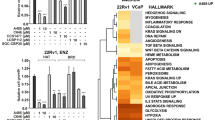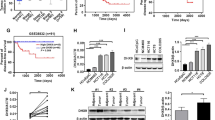Abstract
Multiple studies have shown that steroid receptor coactivator-3 (SRC-3) is upregulated and promotes cell proliferation in several human cancers, including breast, lung, and prostate carcinoma. However, its molecular determinants remain largely unexplored. In the current study, by way of informatics software, we found that MicroRNA-195 (miR-195) could negatively regulate protein levels of SRC-3 through targeting its 3′-untranslated region (3′-UTR) in hepatocellular carcinoma (HCC) cells. As a result, miR-195 mimics inhibited while its antisense enhanced SRC-3 protein levels. Furthermore, miR-195 could modulate cell proliferation and tumor growth in vivo and in vitro. Therefore, our results demonstrate a novel molecular mechanism for the dysregulated expression of SRC-3 in hepatocellular carcinoma.




Similar content being viewed by others
References
York B, O'Malley BW. Steroid receptor coactivator (src) family: Masters of systems biology. J Biol Chem. 2010;285:38743–50.
Xu J, Li Q. Review of the in vivo functions of the p160 steroid receptor coactivator family. Mol Endocrinol (Baltimore, Md). 2003;17:1681–92.
Liao L, Kuang SQ, Yuan Y, Gonzalez SM, O'Malley BW, Xu J. Molecular structure and biological function of the cancer-amplified nuclear receptor coactivator SRC-3/AIB1. J Steroid Biochem Mol Biol. 2002;83:3–14.
Xu J, Liao L, Ning G, Yoshida-Komiya H, Deng C, O'Malley BW. The steroid receptor coactivator src-3 (p/CIP/RAC3/AIB1/ACTR/TRAM-1) is required for normal growth, puberty, female reproductive function, and mammary gland development. Proc Natl Acad Sci U S A. 2000;97:6379–84.
Louet JF, Coste A, Amazit L, Tannour-Louet M, Wu RC, Tsai SY, et al. Oncogenic steroid receptor coactivator-3 is a key regulator of the white adipogenic program. Proc Natl Acad Sci U S A. 2006;103:17868–73.
Coste A, Louet JF, Lagouge M, Lerin C, Antal MC, Meziane H, et al. The genetic ablation of SRC-3 protects against obesity and improves insulin sensitivity by reducing the acetylation of PGC-1{alpha}. Proc Natl Acad Sci U S A. 2008;105:17187–92.
Tien JC, Xu J. Steroid receptor coactivator-3 as a potential molecular target for cancer therapy. Expert Opin Ther Targets. 2012;16:1085–96.
Ma G, Ren Y, Wang K, He J. SRC-3 has a role in cancer other than as a nuclear receptor coactivator. Int J Biol Sci. 2011;7:664–72.
Lydon JP, O'Malley BW. Minireview: Steroid receptor coactivator-3: a multifarious coregulator in mammary gland metastasis. Endocrinology. 2011;152:19–25.
Ling H, Fabbri M, Calin GA. Micrornas and other non-coding rnas as targets for anticancer drug development. Nat Rev Drug Discov. 2013;12:847–65.
Sun K, Lai EC. Adult-specific functions of animal micrornas. Nat Rev Genet. 2013;14:535–48.
Gougelet A, Colnot S. [microrna: new diagnostic and therapeutic tools in liver disease?]. Medecine Sciences. 2013;29:861–7.
Callegari E, Elamin BK, Sabbioni S, Gramantieri L, Negrini M. Role of micrornas in hepatocellular carcinoma: A clinical perspective. OncoTargets and Therapy. 2013;6:1167–78.
Karmakar S, Gao T, Pace MC, Oesterreich S, Smith CL. Cooperative activation of cyclin D1 and progesterone receptor gene expression by the SRC-3 coactivator and SMRT corepressor. Mol Endocrinol. 2010;24:1187–202.
Xu T, Zhu Y, Xiong Y, Ge YY, Yun JP, Zhuang SM. Microrna-195 suppresses tumorigenicity and regulates G1/S transition of human hepatocellular carcinoma cells. Hepatology (Baltimore, Md). 2009;50:113–21.
Yang X, Yu J, Yin J, Xiang Q, Tang H, Lei X. Mir-195 regulates cell apoptosis of human hepatocellular carcinoma cells by targeting LATS2. Die Pharmazie. 2012;67:645–51.
Mussi P, Yu C, O'Malley BW, Xu J. Stimulation of steroid receptor coactivator-3 (src-3) gene overexpression by a positive regulatory loop of E2F1 and SRC-3. Mol Endocrinol (Baltimore, Md). 2006;20:3105–19.
Garabedian MJ, Logan SK. Atypical regulation of SRC-3. Trends Biochem Sci. 2008;33:301–4.
Yi P, Feng Q, Amazit L, Lonard DM, Tsai SY, Tsai MJ, et al. Atypical protein kinase c regulates dual pathways for degradation of the oncogenic coactivator SRC-3/AIB1. Mol Cell. 2008;29:465–76.
Long W, Foulds CE, Qin J, Liu J, Ding C, Lonard DM, et al. ERK3 signals through SRC-3 coactivator to promote human lung cancer cell invasion. J Clin Invest. 2012;122:1869–80.
Acknowledgments
This work was supported by the Science and Technology Program of LiaoNing (2012225019).
Conflicts of interest
None
Author information
Authors and Affiliations
Corresponding author
Electronic supplementary material
Below is the link to the electronic supplementary material.
Supplementary Fig. 1
(a-b) Western blot analysis of SRC-3 expression in HepG2 cells with or without transfection of miR-195 mimics (a), antisense (b) or negative control (NC). (TIFF 216 kb)
Supplementary Fig. 2
(a-b) Western blot analysis of SRC-3 expression in HuH7 cells transfected with miR-195 mimics (a), antisense (b) or negative control (NC). (TIFF 137 kb)
Rights and permissions
About this article
Cite this article
Jiang, HL., Yu, H., Ma, X. et al. MicroRNA-195 regulates steroid receptor coactivator-3 protein expression in hepatocellular carcinoma cells. Tumor Biol. 35, 6955–6960 (2014). https://doi.org/10.1007/s13277-014-1933-x
Received:
Accepted:
Published:
Issue Date:
DOI: https://doi.org/10.1007/s13277-014-1933-x




